
DB-Complete Expert Updated For Delphi 5 serial key or number

DB-Complete Expert Updated For Delphi 5 serial key or number
Direct Oracle Access
Advanced Queueing
To take advantage of the Advanced Queuing option of Oracle8 you can make use of the TOracleQueue component. The TOracleQueue component encapsulates the basic functionality of the DBMS_AQ package. It provides a convenient way to enqueue messages into a queue or to dequeue messages from a queue. Messages can be dequeued in a background thread of your application, and the events that are generated in threaded mode can occur synchronously or asynchronously with the main thread of your applicatio.
Session Pooling
In server applications that frequently need to create sessions to process requests from client applications, it may be useful to use connection pooling. Without a pooling concept, each request could lead to an actual database logon and logoff. By using the TOracleSessionPool component, you can maintain a pool of database sessions that can be used and reused for different requests. You can define the minimum an maximum number of sessions in the pool, define the TimeOut behavior for idle sessions in the pool, and preset the username, password and database.
Support for Oracle specific features
Direct Oracle Access supports many Oracle specific features. Besides the features mentioned above, it supports Oracle8 and Oracle8i features like LOB Locators, Objects & References, XMLTYPE, Timestamps, Scrollable Queries, Password Expiration, External Procedure development, and the Oracle Services for MTS.
System requirements
Direct Oracle Access requires a Windows 95, 98, ME, NT4, 2000, XP, Vista, Windows 7, Windows 8 or Windows 10 client, with Oracle SQL*Net, Net 8, Net 9, Net 10, Net 11, Net 12, Net 18 or Net 19 installed. The supported Oracle Server versions are 7.x, 8.x, 8i, 9i, 10g, 11g, 12c, 18c and 19c on any platform. Direct Oracle Access is available for all recent versions of Delphi and C++Builder.
Trial versions
You can download a fully functional trial version to try out Direct Oracle Access yourself. Visit our ordering page for ordering details and price information. We have a customer list available if you want to get an impression of what organizations are using Direct Oracle Access.
Pricing & Licensing
Standard or Object version
The Direct Oracle Access components are available in two versions, the Standard version and the Object version. The Object version allows you to use Oracle8’s Object extension through the TOracleObject and TOracleReference objects.
Oracle Monitor Pro option
The Oracle Monitor allows you to monitor the database activities that your Direct Oracle Access applications generate. The Lite version is available for free, and the Pro version can be purchased as an option for a Direct Oracle Access license. The Pro version includes additional features like database and network statistics, and query plan analysis.
Service Contract option
If you order an Annual Service Contract for a Direct Oracle Access license, you are entitled to technical support by e-mail and free product upgrades for the period of 1 year. Without this contract, you will receive only patch releases of the Direct Oracle Access version you purchased.
You can order the service contract directly with Direct Oracle Access or at a later time. The service contract can be renewed when it expires after 1 year.
Sourcecode option
You can additionally order the Sourcecode option, which is not related to the number of Direct Oracle Access licenses. Direct Oracle Access is programmed in Delphi, but the sourcecode can be compiled in C++Builder as well.
| Pricing | |
| Direct Oracle Access Standard license | USD 129 |
| Direct Oracle Access Object license | USD 179 |
| Oracle Monitor Pro (per license) | + USD 50 |
| Annual Service Contract (per license) | + USD 50 |
| Additional Sourcecode | + USD 299 |
License terms
For every developer you need to purchase a Direct Oracle Access license and Monitor Pro license. You can additionally order the sourcecode, which may be used by all licensed developers.
You are allowed to build and sell any executable using the Direct Oracle Access components, no royalties are required. You are not allowed to distribute the registered (original or altered) components.
Migration and Upgrade Center
Why Should I Modernize My App?
Experienced developers know that retaining users can be a challenge, so they continuously invest in making their applications faster, more functional and more user-friendly. This effort isn’t for the user alone - cleaning up unused and inefficient code makes it easier for the developer to maintain apps moving forward.
- Windows 7 Support Expired on January 2020. Don't get left behind when your users migrate their desktops to Windows 10. Now is the perfect time to leverage the latest Windows 10 capabilities and plan for future Windows platform support.
- Cross-platform Apps are Necessary. With 73% of internet users turning to their mobile device first, depending on a desktop-only application model limits the usefulness and reach of your app.
- Attract Users with Sleek UIs Users abandon apps that look outdated or aren’t optimized for their device. Now’s the time to wow your users with a design update, made easy with VCL and FMX visual frameworks.
- Refactor and Optimize Code It happens over time… code written ages ago becomes clunky or no longer useful. Take the time to optimize your code and you’ll reap the reward of faster updates, easier maintenance, and better app performance.
Where Should I Start?
Modern apps have sleek UIs that are intuitive to users, are fast performing, and are written to facilitate continuous integration and deployment.
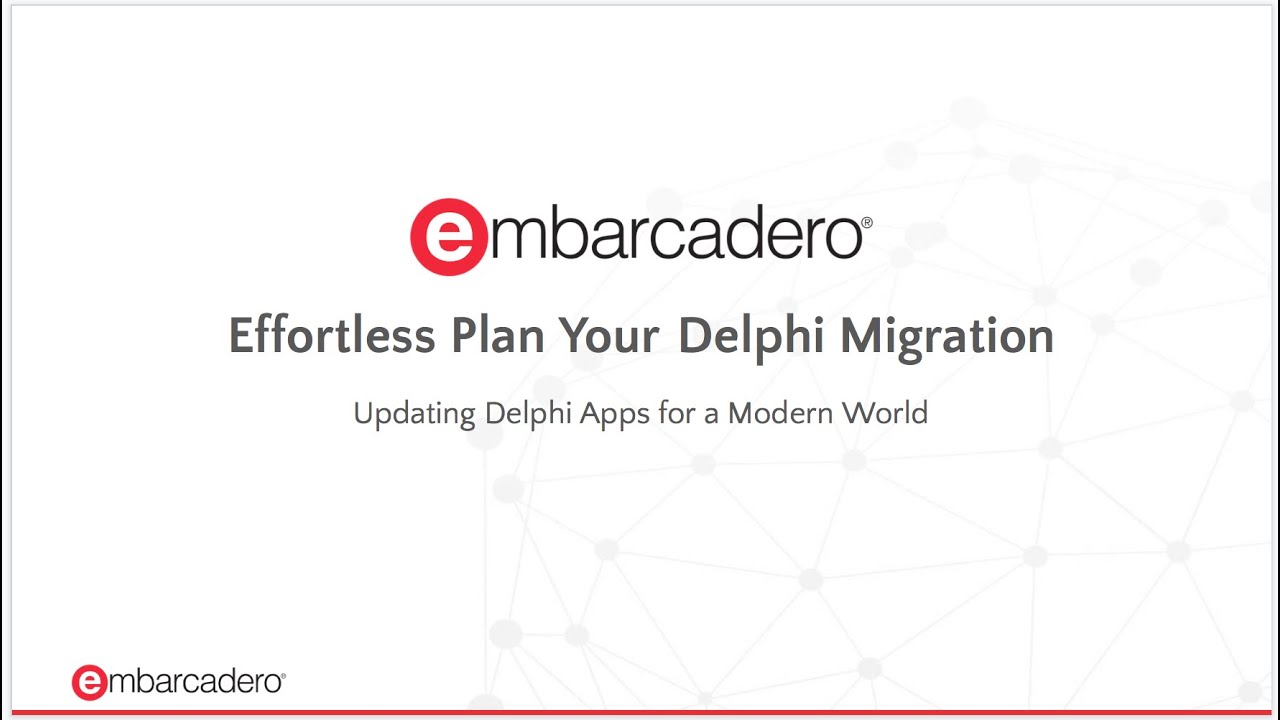
Watch the webinar on Planning and Completing Your Delphi Migration (1 hour)
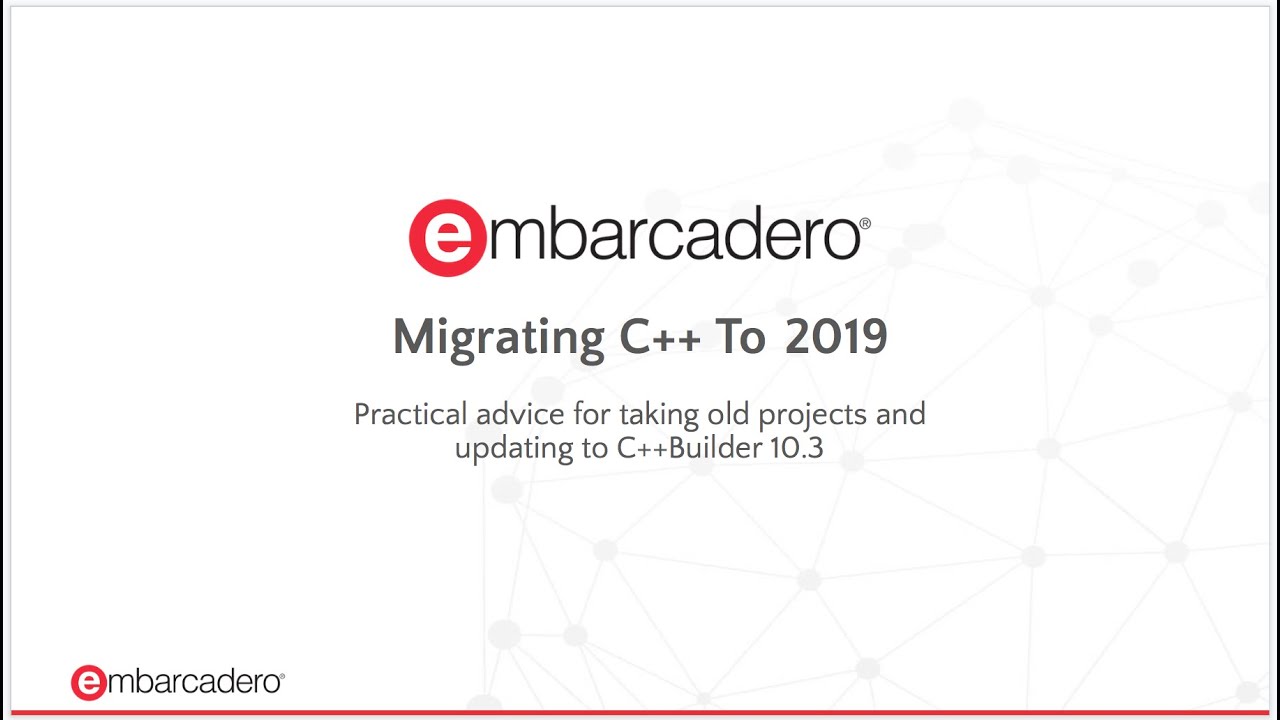
Watch the webinar on Migrating and Modernizing C++ Apps (1 hour)
Yesterday's Tools Won't Cut It
You’ve made the right choice to modernize your legacy apps! In order to be successful, you’ll need to upgrade to the best developer tools available today: RAD Studio 10.4 Sydney.
- Mobile App Support in all Professional, Enterprise and Architect editions enable developers to easily support iOS and Android native apps via one codebase and easily create mobile app UI designs with FMX.
- Updated VCL framework. Design modern Windows UI/UX with support for high DPI capabilities, modern styling, and unmatched responsiveness.
- Implement the best Windows native support features (better than Microsoft itself!)
- Reuse your code to create high-performance micro-services and/or take advantage of containerization
- Ensure no deterioration in application performance with proven frameworks
- Enhance data integration with new connectivity options
- Create Web Clients by leveraging our latest REST API technology
- Leverage existing developer skills and save effort and time migrating code, without a painful re-write required for other languages.
Learn more about specific application migration strategies and technologies below, or get RAD Studio now.
Unicode
Unicode support was added to RAD Studio, Delphi and C++Builder starting with the 2009 version. Many migration resources were developed at that time but are still useful today if upgrading from a pre-Unicode (2007 or earlier) version.
Delphi has made migration over the decades relatively painless, however, this doesn’t mean it’s always effortless and Unicode is one area where some attention may be required!
First, some good news, is many cases legacy Delphi applications that convert to the current Delphi version do so with few or no modifications. If you are working primarily with VCL components (whose support for Unicode has in most cases been considered carefully), or components from third-party vendors who have taken the time to understand the implications of Unicode support, you have an advantage.
Don’t panic if you use “millions of strings” in your application, it does NOT mean you have to change any code at all
Unicode Technical Overview
What determines the need to make any Unicode changes is how you’re using strings and for what purposes. If you’re not doing heavy text processing or manipulations and stick to the standard string operations, mostly likely your code will simply just work. Additionally, just because you have lots of string literals in your code that also doesn’t necessarily mean you have to make any code changes. The most common things that you do have to watch for is file I/O and interfacing with external non-Delphi libraries and/or DLLs.
Unicode Technical Overview
What determines the need to make any Unicode changes is how you’re using strings and for what purposes. If you’re not doing heavy text processing or manipulations and stick to the standard string operations, mostly likely your code will simply just work. Additionally, just because you have lots of string literals in your code that also doesn’t necessarily mean you have to make any code changes. The most common things that you do have to watch for is file I/O and interfacing with external non-Delphi libraries and/or DLLs.
The default string in Unicode Delphi is the new UnicodeString type. By default, the UnicodeString type will have an affinity for UTF-16, the same encoding used by Windows. This is a change from previous non-Unicode versions which had AnsiString as the default type. The Delphi RTL has in the past included the WideString type to handle Unicode data, but this type is not reference-counted as the AnsiString type is, and thus isn’t as full-featured as Delphi developers expect the default string to be.
For the newer Unicode versions of Delphi, a new UnicodeString type has been designed, that incorporates the capabilities of both the AnsiString and WideString types.
A UnicodeString can contain either a Unicode-sized character, or an ANSI byte-sized character. (Note that both the AnsiString and WideString types will remain in place.)
The Char and PChar types will map to WideChar and PWideChar, respectively.
Note, as well, that no string types have disappeared. All the types that developers are used to still exist and work as before. However, for Unicode Delphi, the default string type will be equivalent to UnicodeString.
In addition, the default Char type is WideChar, and the default PChar type is PWideChar.
That is, the following code is declared by the compiler:
With the addition of Unicode as the default string, Delphi can accept, process, and display virtually any alphabet or code page in the world. Applications you build with the newer Unicode versions of Delphi will be able to accept, display, and handle Unicode text with ease, and they will work much better in almost any Windows locale.
In current Unicode versions of Delphi, 'Char' and 'PChar' are now 'WideChar' and 'PWideChar'. You cannot assign an AnsiChar/PAnsiChar to a WideChar/PWideChar, and vice versa, without extra coding.
In any case, such code is redundant in current Unicode Delphi anyway, since AnsiString is now codepage-aware. You can assign any AnsiString-based string type (as AnsiString can be typedefed with a specific codepage at compile-time) to a WideString or UnicodeString, and the RTL will convert the characters to UTF-16 automatically for you.
If you really want to keep the code, then at the very least you should change the AnsiString parameter to a RawByteString (so that it can accept any codepage-specific AnsiString), and then use the new StringCodePage() function to know which codepage the character data is actually encoded as.
For example:
Which can be simplified to this:
One of the most relevant changes since Delphi version 2009 is that String types are now based on Unicode. Previously based on the ANSI standard, the AnsiString and WideString types still work the same way, except regarding their data size in bytes.
Unicode changes, in short:
- String maps UnicodeString, no longer AnsiString
- Char now maps WideChar (2 bytes, not 1 byte) being a UTF-16 character
- PChar maps PWideChar
- AnsiString maps the old String type
No changes were applied to:
- AnsiString
- WideString
- AnsiChar, PAnsiChar
- Short String contains AnsiChar elements
- Implicit conversions still work.
The user's active code page controls the mode (ANSI vs. Unicode), so that ANSI strings are still supported.
Operations that do not depend on character size:
- String concatenation
- Standard String functions. E.g., Length, Copy, Pos, and so on.
- Operators. E.g.,
- FillChar (
- Windows API
Operations involving the character size (measured in bytes) may require a few changes. Nothing too complicated, but here’s a tip: pay special attention to code in which you:
- Assume Sizeof (Char) is 1.
- Assume the size of a string equals the number of bytes in the string.
- Handle String or PChars directly.
- Saves or reads a string from/to a file.
Items 1 and 2 do not apply to Unicode, because in Unicode the Sizeof (Char) is 2 bytes and the size of a string is twice as big as the number of bytes. Besides, the code that reads and saves files must understand the right number of bytes to perform those operations, for a character is no longer represented as 1 byte.
Unicode Resources
As a start, look at these great white papers, technical articles, videos and migration tools to help you out with Delphi and Migration to Unicode:
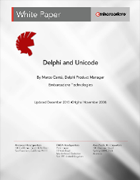
Delphi and Unicode This white paper has been written to help developers that are using versions of Delphi or RAD Studio that were released previous to the launch of Delphi 2009. Read this paper if you are looking for more information on why and how to Unicode-enable a codebase that has been developed using a pre-Unicode enabled version.
Download the free white paper now
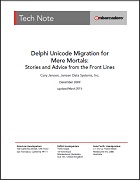
Stories and Advice from the Front Lines
Whether you are in the early planning stages of migrating an existing application to Unicode-enabled RAD Studio, or in the midst of the process, Delphi Unicode Migration for Mere Mortals can help. Written with input from many of the leaders in the RAD Studio community, this white paper provides you with valuable techniques and advice that will smooth the way.
Download the free white paper now
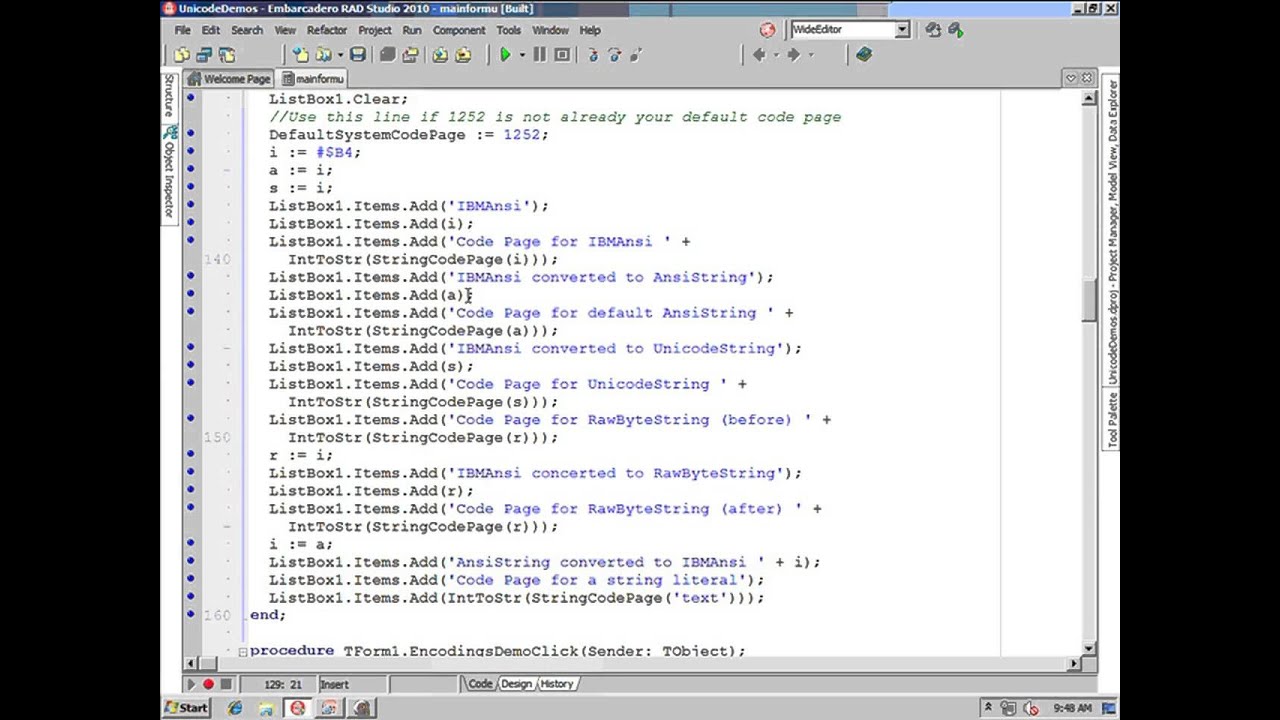
Webinar: Migrating Legacy Applications to Unicode-enabled Delphi with Cary Jensen
Cary Jensen has worked with Delphi developers around the world – including noted authors, leading third-party vendors, and front line developers – to learn how they approached their Unicode conversions, what challenges they faced, and what solutions they employed. Learn best practices for migration to Unicode in this informative webinar.
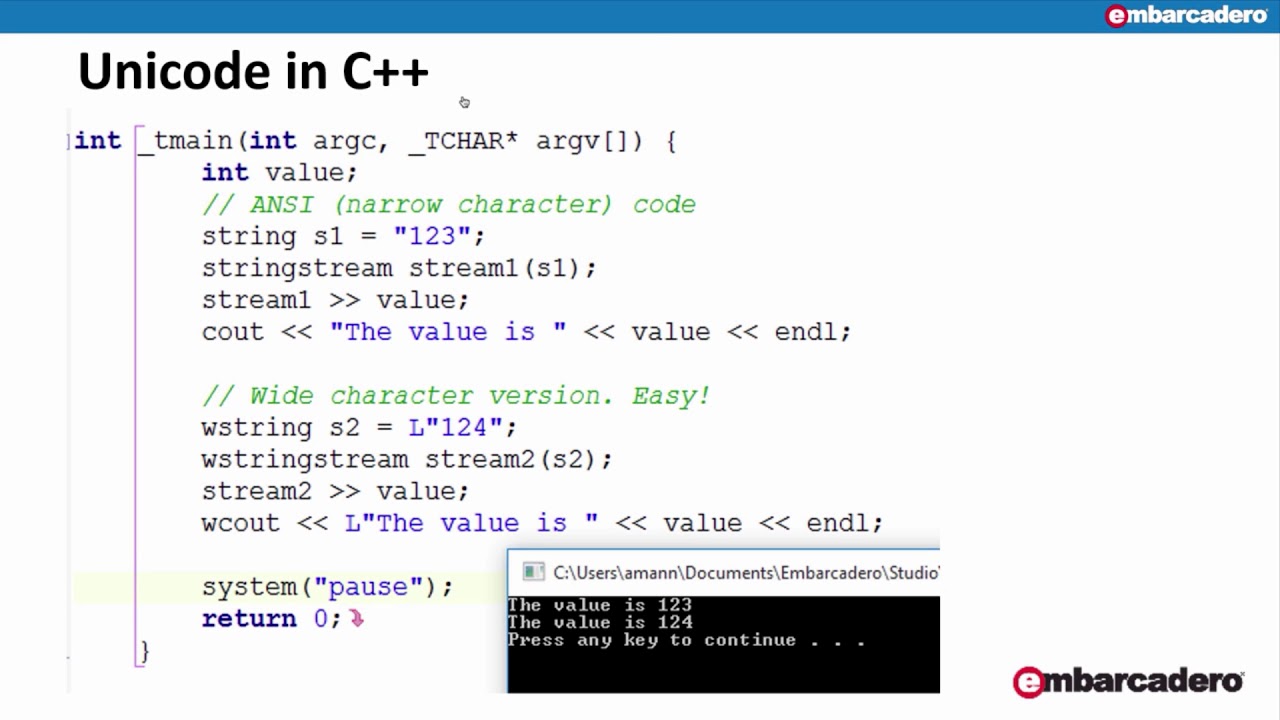
Migrating your legacy C++Builder applications to unicode
Unicode Statistics Tool on your Delphi application and check if any Unicode changes are needed.
This Unicode Statistics Tool will assist you in collecting useful statistics for the time and effort needed to migrate your Delphi applications to Unicode.
The tool reviews your code and tells you where and what you will most likely have to change. This will at least give you an estimate of how many lines need to be reviewed.
NOTE: The Unicode Statistics Tool does not know if any of your lines of code really needs to be modified or replaced at all. It does tell you have at least some number of lines you should take a quick glance at. It could be as little as 0 changes needed. It really all depends on how you are using Strings and Chars in your application.
The result is Delphi is 100% Unicode. The migration is easy, the Visual Component Library (VCL) and the compiler handle many things.
The tool lists all used units, including Delphi units (and how many times each one was used), number of files, number of lines, and number of instances of String, Read, Write, SizeOf, etc.
Migrating to 64bit
Ever since Delphi XE2, it has been possible to generate Delphi 64bit applications from the same code base as your traditional Windows 32bit Delphi code. The business case for 64-bit for business is covered in this tech paper The Impact of 64-bit Applications to your Company’s Bottom Line
On the whole moving to 64bit (on Windows, but also iOS) is beautifully simple to achieve! It can be just as simple as adding the 64bit target platform in the project manager and rebuilding the project. This is a massive benefit over other languages that need different types declared to resolve the difference between the two platforms.
64bit Resources
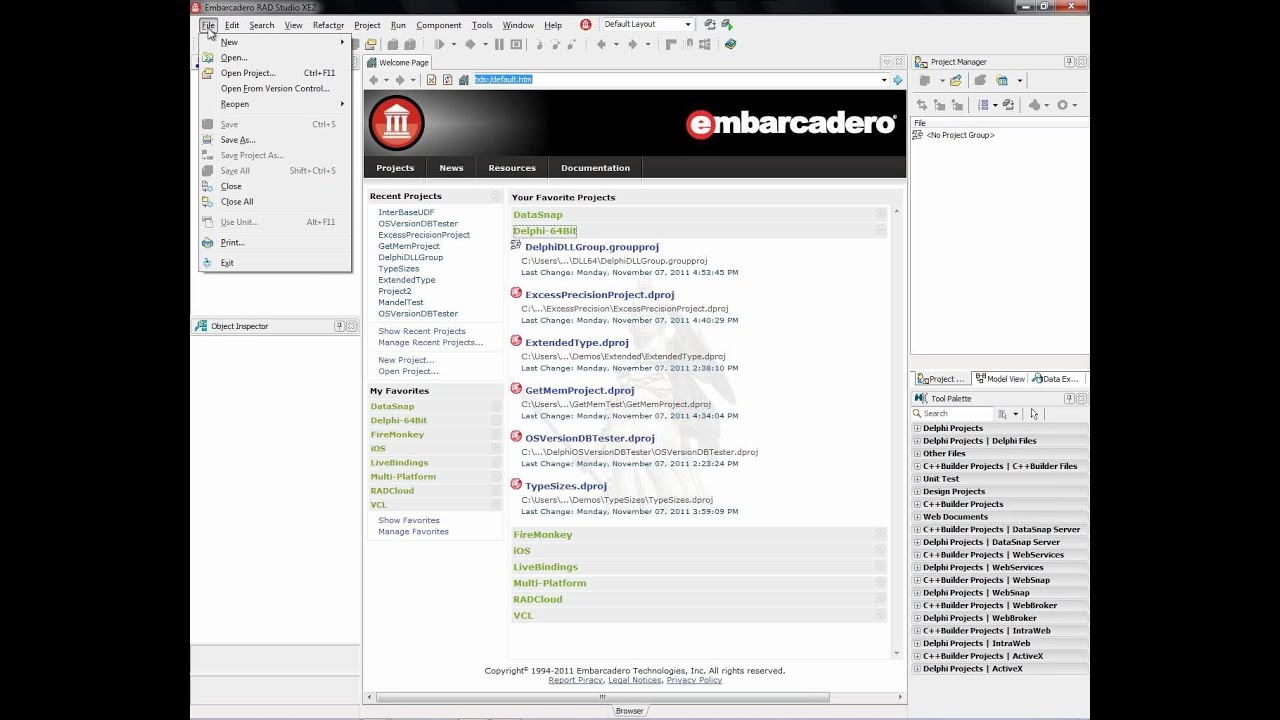
Building 64bit Applications with Delphi
Overview of how to build 64-bit Delphi applications with this short tutorial.
[7m16sec]
Delphi 64bit Code by Stephen Ball covering what is the same, what is different, predefine conditional compiler options and using assembler code.
Delphi 64bit code
Migrations of Database and Middleware
Migrating from the Borland Database Engine (BDE) or DBExpress
The Borland Database Engine (BDE) has been deprecated, and beginning with version XE8 the BDE has been removed from the Delphi installation, but is still available as a separate download from Code Central. All applications using the BDE are recommended to be migrated to FireDAC. If you are new to FireDAC Data Access Components, start here and look at the First Steps and Getting Started links.
dbExpress is also in maintenance only mode and users should look to migrate to FireDAC which offers more databases, is faster and provides more features.
Database Resources

FireDAC Skill Sprints - Migrating BDE applications to FireDAC and InterBase - David I
Featured RAD Studio tool reFind
Using reFind you can convert your code automatically from BDE to FireDAC, including updating uses clauses, field definitions.
docwiki | Blog
DocWiki Migrating dbExpres to FireDAC
This article provides a tutorial showing how to migrate a simple client-server application using dbExpress data access components, such as TSQLConnection, TSQLQuery, TSQLTable, to FireDAC
docwiki
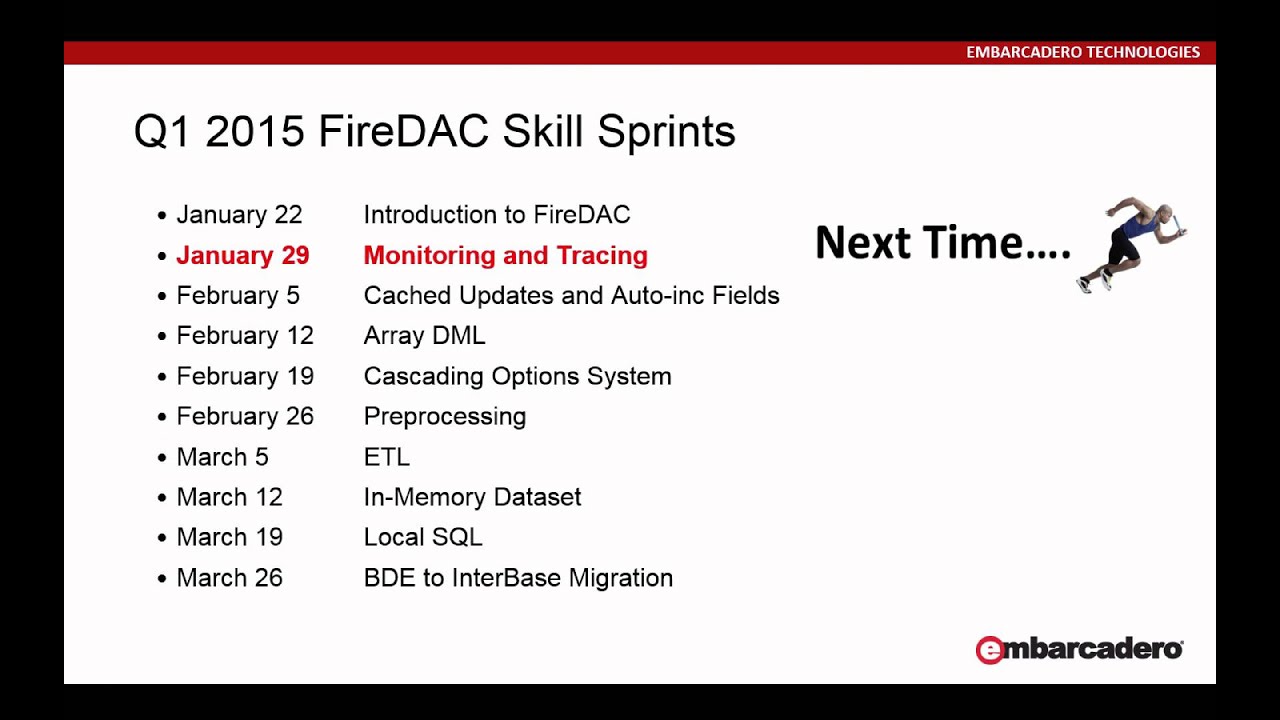
FireDAC Skill Sprints is a series of 12 x 20minute videos teaching you the advanced features of FireDAC
Entire video playlist.
Migrating 3rd Party Components / Libraries
What 3rd party libraries (components) are you using in your older Delphi?
The 3rd party plug-ins (libraries) need to be rebuilt in the current Delphi version. Having the source code makes this easier. You will need to re-compile your 3rd party components / libraries from older Delphi using the current Delphi 10.1 version so the components and libraries can be used in current Delphi projects.
Any 3rd party components / libraries without the source code may need updated versions for the current Delphi 10.1 version.
Check this link for some of the third party components available with RAD Studio and you can search all tools and components on the Embarcadero Technology Partner Directory.
The current Delphi includes the new Getit Package Manager to allow you to browse, download, purchase, and install GetIt packages into the current Delphi version. GetIt currently includes 31 of the popular free packages such as libraries, components, IDE extensions, and SDKs, like Open Source “TurboPack” Components, JEDI Visual Component Library, etc., certified to work in the current Delphi version!
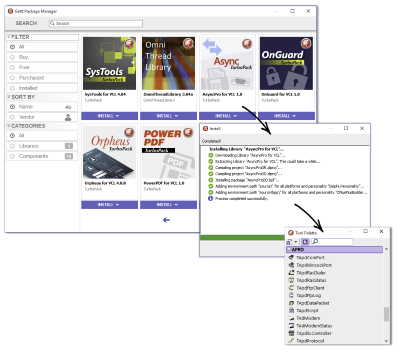
10 Tips For Making Your Mobile App Succeed
Monetize Your App Using In App Payments And Ads
Ads are a good way to monetize your apps. Use full screen interstitial ads at the start of your app and at natural stopping points. Integrate leaderboard ads (320x50) into either the header or footer where it makes sense for your interface. Over at AppBrain Stats they have a list of the most popular ad networks that include Admob, Millennial Media, InMobi, Chartboost, Tapjoy and many more. Add in-app payments for consumable, one time purchase, and subscription-based revenue. Offer both a paid version with no ads and a free version of your app. Provide a way to disable ads in the free version via an in-app purchase.
Secure Your App’s Data Connections With SSL
Mobile users are more mobile than ever these days and they jump from secured wireless access point to 4G to unsecured wireless hotspot multiple times per day. If you want to keep your user’s data secure from the prying eyes of just about anyone using a network packet sniffer you will want to implement industry standard encryption like TLS/SSL (Transport Layer Security/Secure Sockets Layer). Using a good tried and true third party library is the way to go.
Encourage Users To Rate Your App
A good rating in the various app stores is more important than ever. Usually only people who want to give your app a low rating end up on app store rating pages and rate your app down. You can encourage users who love your app to rate your app by pointing them in the right direction. The third time a user uses your app is good time to ask them to visit the rating page for your app on the app store of your choice.
Create And Deploy Icons For Your App
Having a great looking icon is a must have to increase your chance of success in the app stores. There are more than 30 different icon sizes that you need to create and deploy for Android and iOS apps. This can be a real chore to create all of the icons needed. There are utilities out there that can help you do that like Mobile Gfx Setup, Paint.net and Adobe Flash CC is a more advanced commercial Windows program that comes with a free trial and you can create and export your icons pretty easily in it as well.
Handle App Activate And Deactivate Lifecycle Events
Once you have the features in your app all finished you aren’t done. One reason why some apps succeed and others do not is because of the polish that goes into them. There are events on both Android and iOS which will tell your app when it becomes active or goes into the background. You should find and handle these events so that your app has a slick user experience. Test and handle all of the various actions in your app like going into sleep mode and coming back out or pressing the back button.
Don’t Fly Blind. Add Analytics To Your App
Implementing analytics using various third party analytics libraries like Google Analytics, Flurry Analytics, GameAnalytics and Parse Analytics to name a few. Analytics providers have their own Android, iOS, and REST SDKs that you can integrate. Track important data points like how long a user uses your app, which screens do they use to most, and where they may get stuck or leave your app. Most important of all is to take action on the information that the analytics give you. Iterate and test. Iterate and test.
Setup Push Notifications
Push are an important mechanism for keep your users engaged with your app. Try to find a balance between sending too many and not sending enough push notification to keep users engaged. Android push notifications are available through Google Cloud Messaging. iOS push notifications are available through the Apple Push Notification Service. Implementing push notifications can be tough but third party providers like Parse, PushWoosh, and Upsight (formerly Playhaven) make it easier for you.
Use Threads To Keep Your App Responsive
Threads allow you to execute long running procedures in a separate process. Use threads anywhere your app would block user input like uploading and downloading files, processing information or loading data. If your app appears frozen users may exit and move on to the next app. If a user is sitting on a screen waiting for something to happen, think about how you can rearchitect your app so that the event they are waiting for happens in the background instead.
Check Network Connectivity Before Trying To Connect
Mobile device connectivity is not a sure thing. If your app needs internet access you need to handle the scenario when connectivity is not available. Using queuing systems for uploading and downloading data. Implement file download resuming where possible. An offline mode where online only features are disabled while connectivity is unavailable may be a good idea.
Optimize Your App Name, Description and Distribution
Choose a functional name, descriptive, or a unique name (or a combination) to help your app succeed. Stay away from trademarked terms. A good description that lays out what your app does, who your competitors are and what technologies you used to build it can help people find your app. Building your app is just the beginning. Distribution is also key to a successful app so make sure if your app runs on both Android and iOS that you deploy it to the biggest app stores like Google Play, Apple App Store, Amazon Appstore, and Samsung Apps. Each app store has their own submission process and guidelines but the extra boost in users you get is worth it. You may just find your niche on the Amazon Appstore or Samsung Apps.
Protocol for a Delphi consensus exercise to identify a core set of criteria for selecting health related outcome measures (HROM) to be used in primary health care
Collection of outcomes for use in evaluation of health care, quality improvement, clinical decision-making or effectiveness research continues to be promoted and encouraged. Routine collection of health related outcomes can occur in more formal contexts, for example in developing patient or disease registries, or less formal where findings are documented in individual patient charts. Collection of health related outcomes can be used at a system level or for individual patient management. In either case, the dilemma remains as to which health related outcomes to select that accurately captures the intended purposes for collection. There are a large number of criteria that could be considered to select outcomes which makes the process challenging.
Several attempts to establish a minimum or core set of criteria used to evaluate or select outcomes have been reported [1,2,3,4,5,6]. However, there are important limitations in these previous recommendations. Some focus predominately on patient reported [1] or psychological/ behavioural outcomes [2, 3]; there are many other types of measures used to assess the impact of care. Another attempt was developed in the context of comparing clinical trials and using an agreed upon set of common outcomes [4]. Similarly another is to be considered broadly at a systems level and not readily operationalized with consistency [5, 6]. Although helpful, these previous criteria recommended to select outcomes may not be applicable for all types of outcomes or in other contexts in which they were developed.
This paper will detail a protocol to establish criteria for selecting health related outcome measures (HROM) in the context of primary health care (PHC). PHC is characterized by patients with multifactorial health problems and accordingly the interventions are multilayered and complex. We propose a Delphi consensus study that includes experts in HROM development and clinical research. We provide background information around definitions and use of HROM, previous attempts to establish criteria to select measures, hypothesized benefits and use of HROM in clinical settings, the relevance to the PHC context and evaluation of complex interventions generally. The proposed research protocol details are specified and previous gaps in the literature are addressed. The overall goal of this research is to contribute to the development of a transparent and reproducible process to select HROM that will be used across different sites that are implementing and adapting complex PHC interventions.
Purpose and definition of outcomes and health related outcome measures
Apart from the practical and logistical aspects of routine collection of health related outcomes for evaluation purposes, there are some challenges conceptually in defining what is and is not an outcome. This is related to the variation in definitions of an outcome generally, as well as, definitions of an outcome measure and an outcome assessment [7,8,9,10,11,12,13,14,15,16,17,18,19,20,21,22,23]. The term outcome is often used in a global sense to connect the expected impact of an intervention. It is also used frequently to refer to instruments or scales used to assess or evaluate interventions or patient status at any point in the health care trajectory. The term outcome may be confused with the term endpoint (which sometimes is defined as a group of outcomes used to establish the benefit or harm of an intervention).
For the purposes of this paper we have adopted the definition of an outcome as one that captures a “measureable characteristic that is influenced or affected by an individuals’ baseline state or an intervention as in a clinical trial or other exposure” [8, 19]. An outcome could reflect both the benefit or harm to a patient who receives an intervention and exposure [10]. This definition is in keeping with the Donabedian framework for quality improvement which defines outcome as the “effects of care on the health status of patients and populations” [11]. Outcome assessment is considered to be the most important of three categories of assessment of quality of care (including structure (context where care is delivered and including buildings, equipment, staffing, etc.) and process (interactions between patients, providers, system) [11, 24, 25]. In this quality improvement framework, the focus of outcomes is on the impact of care on the person receiving it. Ideally the assessment of outcome of care should always reflect what patients actually experience and consider important [26]. Thus HROM are measures or scales or instruments that are designed to capture outcomes (domains and constructs) in a health care context.
What is key in this definition of outcomes and HROM is that it is not the specific type of measure or instrument or test that is used in the assessment but rather the intended purpose of the outcome measurement and the timing of the collection during care receiving. For example, consider hemoglobin A1c in the care of patients with diabetes. Capture of the frequency of measurement of hemoglobin A1c can be used to assess health service processes; estimation of the mean level (or mean change) can be used to assess the impact of the health services outcome (on the recipient). The influential Food and Drug Administration (FDA) in the United States considers a clinical outcome assessment as one that may use any of four primary types of “outcome measures” that would reflect domains important to relevant stakeholders and these include: patient reported outcome measures (PROM) or (PRO), observer reported outcomes (ObsRO), clinician reported outcomes (ClinRO), and performance outcomes (PerfO). In the FDA regulatory process, laboratory tests, biomarkers, and even mortality/survival are also important types of outcomes that can be used to assess the effectiveness of interventions (in their regulatory capacity, this refers to drugs, devices and biomarkers) for which approval is sought. This broad understanding of HROM and their potential classification are useful in understanding outcome assessment generally.
Use of HROM as an intervention
Promoting the capture of HROM in daily practice has long been a goal for assessing the effectiveness of care provided to patients [27]. However, it is only recently that there is increasing recognition that the routine collection and interpretation of HROM in practice can be shown to influence ongoing care, such that it becomes an intervention in and of itself. Greenhalgh [28, 29] hypothesized pathways of influence and impact of using PROM in clinical settings. Within this hypothesized model, the use of PROM (a type of HROM) will prompt clinicians to discuss health related quality of life concerns, it will enable clinicians to detect unrecognised problems, and will likely change the way in which a clinician will respond (as the findings from the PROM may show a change in the health related quality of life . The act of reviewing or using PROM serves to monitor treatment potentially resulting in changes to the patient’s behaviour and improvement in the patient’s overall health status or satisfaction with care. Thus, outcome assessment by collecting HROM not only evaluates the impact of an intervention at the resolution or end of a particular episode of care, but it can be considered an added “intervention” that serves to direct or modify care. For example, the rate of screening for depression is one outcome that could be used to demonstrate the impact of a routine visit to a family doctor. However, if the screening result is positive, then the physician will now direct care to address this previously undetected health problem. In the context of PHC, like other areas of health care provision, a wide spectrum of HROM are used to assess both simple and complex interventions and single and comorbid health conditions. Added to this complexity is that most visits to PHC are for symptoms or complaints rather than diseases so the range of available HROM related to single diseases are less appropriate [30].
It is not clear which of types of HROM should be selected to provide useful information to assess the impact of care or to allow clinicians and decision-makers to direct or modify care. What is an ideal HROM in one context may not be so in another context and in part reflects the intended purpose of the outcome assessment. The challenge for clinicians, researchers and decision-makers is to select the most appropriate HROM in light of the fact that likely several well established HROM currently exist and are candidates for selection. Although there have been some attempts to set some general guidelines for selecting HROM for outcome assessment, these criteria have several key limitations that have been noted and none provide recommendations for dealing with equally valid but competing measures.
Hypothesized benefits of using HROM in clinical settings
Donabedian was one of the first to propose that structure, process and outcomes are seminal to evaluating quality of care [24, 25]. Since the late 1960s there has been great emphasis on the selection and use of HROM in quality assessment but also in effectiveness research and even directing clinical decision-making for individual patients. As noted previously, Greenhalgh [28, 29] hypothesized pathways of influence and impact of using PROM in clinical settings. Within this model, PROM can be considered as having multiple purposes that include “clinical tests”, “interventions” and “outcomes”. Table 1 details how the model specifies the clinical goal when using PROM and the potential impact of using these in clinical settings. Note that this model may be applied to HROM, as the definition of HROM includes PROM (as well as, ObsRO, ClinRO, PerfO).
When considering the clinical goals (i.e., assess change, monitor, detect, etc.) for using an HROM, it is not clear if the criteria used to select measures will vary as a function of the specific purpose. It is likely that the criteria may vary not only as a function of the clinical purpose for using the HROM, but also the health domain being assessed by the tool and for other administrative concerns. Soliciting expert opinions on this issue would add to the knowledge of how to apply HROM for clinical, administrative, or research purposes.
Primary health care context and complex interventions
In the context of PHC, there is increasing recognition that most interventions are complex. The Medical Research Council (United Kingdom) has been instrumental in conceptualizing the issues related to developing, evaluating, and reporting on complex interventions [31]. Complex interventions are characterized by having a number of interactions between components and requiring a number of different behaviours by those delivering or receiving the intervention [31]. Adding to this definition is that a number of groups and organizational levels are affected by the intervention. Although some would make the distinction between the complexity of the intervention versus the complexity of the health system [32] the two components interact. Flexibility and adaptation characterize complex interventions [31]. Practically this means that changes in implementation of an intervention are to be expected. More importantly, it follows that a number of outcomes may be required, as well as variability in outcomes assessing the same attribute of interest [31]. This would suggest that adaptations of interventions in one component of a health system may result in the need to select different or modify existing HROM relative to that context. The benefit of this is that it reflects the varying and flexible aspects of PHC interventions and therefore reflects strengths of the interventions in different settings.
The development of this Delphi consensus study is considered in the context of such a complex intervention. Health TAPESTRY is a novel intervention currently being implemented in Canadian PHC settings and undergoing evaluation in a randomized trial. The intervention components involve patients, volunteers, health care teams, and researchers, as well as, the use of an electronic patient health record accessed by all relevant stakeholders [33]. There are several affiliates of Health TAPESTRY across different sites in Canada that vary in their patient populations and focus in PHC services. As expected, each Health TAPESTRY site currently uses different HROM (or will need to select new HROM), and this may present challenges for evaluating benefits and quality of this complex intervention. One overriding goal of Health TAPESTRY is to integrate new and old functionality within and across each of these centres. As the Health TAPESTRY intervention is being adapted and implemented it did not seem feasible to enforce standardization of HROM. However, stakeholders acknowledge that there is a need to guide selection of key HROM to be used in evaluating the impact of the Health TAPESTRY intervention across implementation sites. Health TAPESTRY serves as a quintessential example of PHC issues and the complexity of evaluation. Recognizing the potential for differences across Health TAPESTRY sites, a valid and trustworthy process to review and accept suggestions for HROM is needed to allow for evaluation of effectiveness and impact across sites. To our knowledge there is no guideline or consensus on criteria to select HROM within a PHC setting.
What’s New in the DB-Complete Expert Updated For Delphi 5 serial key or number?
Screen Shot

System Requirements for DB-Complete Expert Updated For Delphi 5 serial key or number
- First, download the DB-Complete Expert Updated For Delphi 5 serial key or number
-
You can download its setup from given links:


